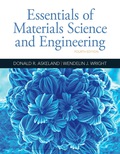
Interpretation:
The carburizing time necessary to achieve a carbon concentration of
Concept introduction:
Consider the following expression of Fick's second law.
Here,
Calculate the diffusion coefficient at
Here,
Trending nowThis is a popular solution!

Chapter 5 Solutions
Essentials Of Materials Science And Engineering
- Q9 A single-phase transformer, 2500 / 250 V, 50 kVA, 50 Hz has the following parameters, the Primary and secondary resistances are 0.8 ohm and 0.012 ohm respectively, the primary and secondary reactance are 4 ohm and 0.04 ohm respectively and the transformer gives 96% maximum efficiency at 75% full-load. The magnetizing component of-load current is 1.2 A on 2500 V side. 1- Draw the equivalent circuit referred to primary (H.V side) and inserts all the values in it 2- Find out Ammeter, voltmeter and wattmeter readings on open-circuit and short-circuit test. If supply is given to 2500 V side in both cases. Ans. O.C. Test (Vo= 2500 V, lo=1.24 A, Wo=781.25 w) S.C. Test (Vsc =164.924 V, Isc =20 A, Wsc =800 w )arrow_forward1. Create a Book record that implements the Comparable interface, comparing the Book objects by year - title: String > - author: String - year: int Book + compareTo(other Book: Book): int + toString(): String Submit your source code on Canvas (Copy your code to text box or upload.java file) > Comparable 2. Create a main method in Book record. 1) In the main method, create an array of 2 objects of Book with your choice of title, author, and year. 2) Sort the array by year 3) Print the object. Override the toString in Book to match the example output: @Javadoc Declaration Console X Properties Book [Java Application] /Users/kuan/.p2/pool/plugins/org.eclipse.justj.openjdk.hotspo [Book: year=1901, Book: year=2010]arrow_forwardA modulating signal f(t) is bandlimited to 5.5 kHz is sampled at a rate of 15000 samples/sec. The samples are quantized into 1024 levels. Calculate transmission bandwidth if the following modulation types are used for signal transmission: 1-ASK, QAM 2-QPSK, 8-PSK 3-FSK, 8-FSK with Af = 20 kHzarrow_forward
- Q10 The full-load copper loss on the H.V. side of 100KVA, 11000/317 V, single-phase transformer is 0.62 kw and on the L.V. side is 0.48 kW. i) Calculate R1, R2 in ohms ii) Find X1,X2,if the percentage equivalent reactance is 4%, and reactance is divided in same proportion as resistance. Ans, 27.30, 0.175), 0.00482 . (7.5)arrow_forwardFind the binary sequence, for the following Differential Manchester code.arrow_forwardQ2- What are the parameters and loss that can be determined during open-circuit test of singlephase transformer. Draw the circuit diagram of open-circuit test and explain how can you calculate the Parameters and loss.arrow_forward
- Q6- the open circuit and short circuit tests on a 10 KVA, 125/250 v, 50 Hz single phase transformer gave the following results: O.C. Test: 125 V,0.6 A, 50 W ( on L.V.) S.C. Test: 20 V, 40 A, 177.78 W (on H.V. side) Calculate: i) Copper losses on half load ii) Full load efficiency at 0.8 leading p.f. iii) Half load efficiency at 0.8 leading p.f. iv) Regulation at full load at 0.9 leading p.f. Ans: 44.445 W, 97.23%, 97.69%, -1.8015%arrow_forwardQ3-A two-winding transformer has a primary winding with 208 turns and a secondary winding with 6 turns. The primary winding is connected to a 4160V system. What is the secondary voltage at no load? What is the current in the primary winding with a 50-amp load connected to the secondary winding? What is the apparent power flowing in the primary and secondary circuits? Ans. 120 V, 1.44 A, 6000 VAarrow_forwardQ12- A three phase transformer 3300/400 V,has D/Y connected and working on 50Hz. The line current on the primary side is 12A and secondary has a balanced load at 0.8 lagging p.f. Determine the i) Secondary phase voltage ii) Line current iii) Output power Ans. (230.95 V, 99.11 A, 54.94 kW)arrow_forward
- Q1- A single phase transformer consumes 2 A on no load at p.f. 0.208 lagging. The turns ratio is 2/1 (step down). If the loads on the secondary is 25 A at a p.f. 0.866 lagging. Find the primary current and power factor.arrow_forwardQ5-The efficiency of a 200 KVA, single phase transformer is 98% when operating at full load 0.8 lagging p.f. the iron losses in the transformer is 2000 watt. Calculate the i) Full load copper losses ii) half load copper losses and efficiency at half load. Ans: 1265.306 watt, 97.186%arrow_forwardQ7- A 5 KVA, 500/250 V,50 Hz, single phase transformer gave the following reading: O.C. Test: 250 V,2 A, 50 W (H.V. side open) S.C. Test: 25 V10 A, 60 W (L.V. side shorted) Determine: i) The efficiency on full load, 0.8 lagging p.f. ii) The voltage regulation on full load, 0.8 leading p.f. iii) Draw the equivalent circuit referred to primary and insert all the values it.arrow_forward
 MATLAB: An Introduction with ApplicationsEngineeringISBN:9781119256830Author:Amos GilatPublisher:John Wiley & Sons Inc
MATLAB: An Introduction with ApplicationsEngineeringISBN:9781119256830Author:Amos GilatPublisher:John Wiley & Sons Inc Essentials Of Materials Science And EngineeringEngineeringISBN:9781337385497Author:WRIGHT, Wendelin J.Publisher:Cengage,
Essentials Of Materials Science And EngineeringEngineeringISBN:9781337385497Author:WRIGHT, Wendelin J.Publisher:Cengage, Industrial Motor ControlEngineeringISBN:9781133691808Author:Stephen HermanPublisher:Cengage Learning
Industrial Motor ControlEngineeringISBN:9781133691808Author:Stephen HermanPublisher:Cengage Learning Basics Of Engineering EconomyEngineeringISBN:9780073376356Author:Leland Blank, Anthony TarquinPublisher:MCGRAW-HILL HIGHER EDUCATION
Basics Of Engineering EconomyEngineeringISBN:9780073376356Author:Leland Blank, Anthony TarquinPublisher:MCGRAW-HILL HIGHER EDUCATION Structural Steel Design (6th Edition)EngineeringISBN:9780134589657Author:Jack C. McCormac, Stephen F. CsernakPublisher:PEARSON
Structural Steel Design (6th Edition)EngineeringISBN:9780134589657Author:Jack C. McCormac, Stephen F. CsernakPublisher:PEARSON Fundamentals of Materials Science and Engineering...EngineeringISBN:9781119175483Author:William D. Callister Jr., David G. RethwischPublisher:WILEY
Fundamentals of Materials Science and Engineering...EngineeringISBN:9781119175483Author:William D. Callister Jr., David G. RethwischPublisher:WILEY





